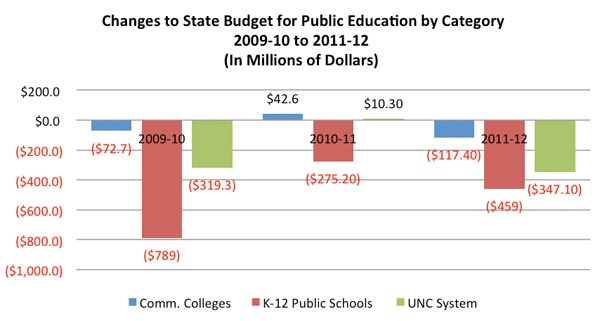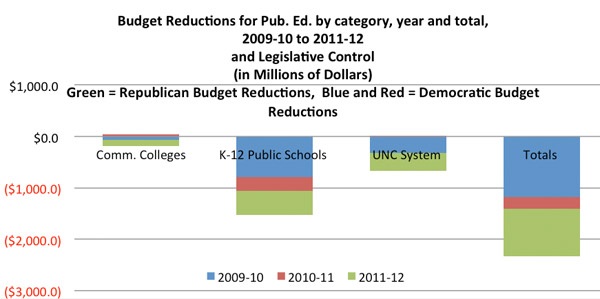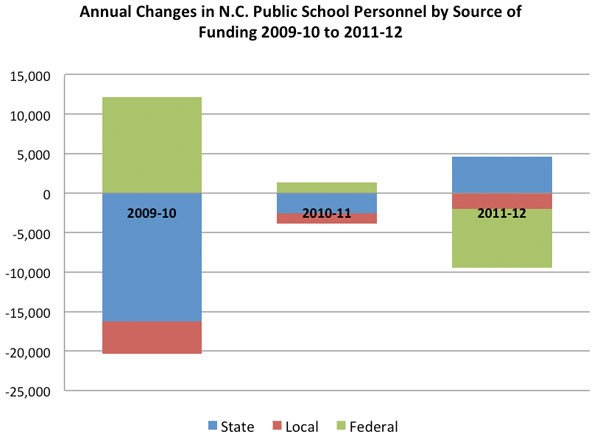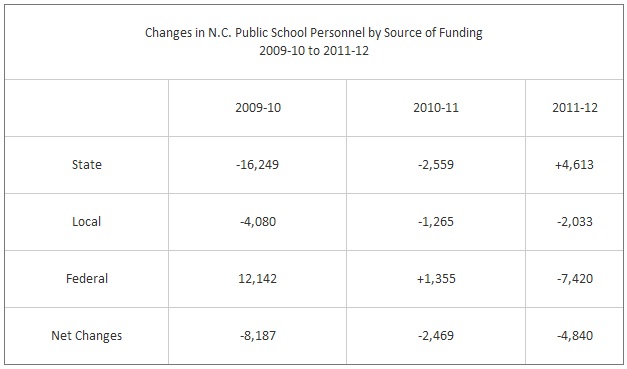Publisher's note: This post, by Bob Luebke, was originally published in the Education of Civitas's online edition.
The debate over the State budget's impact on public education has generated much heat and little light in the last few weeks. Democrats point to large budget reductions, personnel losses and talk of the devastating long-term consequences on students and the public schools. Republicans dispute the claims, saying that funding was actually increased to add school staffing. The GOP in turn accuses Democrats of having no plan to replace federal stimulus funding. Who's right? Let's take a closer look at some of the most common claims regarding budget reductions and the loss of school personnel.
Budget Reductions
Democrats cite deep budget cuts as a sign of the Republican party's hostility toward the public schools. However, a close review shows the last three state budgets, not just the current one, have been filled with red ink. Chart I and Chart II provide information on the dollar size of cuts to public education (i.e., K-12 public schools, community colleges and the UNC System) from 2009-10 to 2011-12.
Over the three year period, total budget cuts to public education totaled $2.32 billion. For two of those years (2009-10 and 2010-11) both the General Assembly and the Office of the Governor were controlled by Democrats. In 2011-12 -- for the first time in over a century -- Republicans won control of both the House and the Senate.
Now let's look at the actual budgets for public education during those periods.
In 2011-12, Republicans overrode a Perdue veto and approved a budget that reduced the budgets for the public schools, community colleges and UNC System by a combined $923.6 million. Of that amount, budget reductions for the public schools totaled $459 million. Reductions for community colleges and the UNC System were $117.4 million and $347.1 million respectively
Criticism of the 2011-12 budget cuts for public education often implies that the size and scope of the reductions constituted a dramatic break from recent budgets. In the previous year, 2010-11, however, the budget for public education was cut by $222.3 million. That amount included total reductions of $275.2 million for the public schools as well as small net increases for community colleges ($42.6 million) and the UNC System ($10.3 million). While these reductions may seem less than present reductions, they followed big cuts the previous year. In 2009-10, the first full year of recessionary budget reductions, Democrats reduced the budget for public education by $1.1 billion. Their cuts to K-12 public schools topped $789 million, while the UNC budget was reduced by $319.3 million.
What does it all mean? Let's put a picture to these numbers. Over the past three years, public education (K-12, community colleges and UNC System) has incurred about $2.3 billion in budget reductions. Chart II details the size of budget reductions by category year and legislative control. A simple comparison reveals the last budget cycle when Republicans authored and approved the state budget over the veto of Gov. Perdue accounts for approximately 40 percent of the budget reductions made for public education since 2009-10. Republican budget reductions for public education total $923.6 million.
However, for the two prior budgets, Democrats reduced the budget for public education a combined $1.4 billion. If we limit the discussion to K-12 budget reductions, the $459 million in Republican budget reductions represents only 30 percent of a total $1.5 billion in budget reductions made to K-12 public education in the three state budgets since 2009-10. Put another way, in the two years prior to 2011-12, Democrat cuts to public education were nearly two-and-one-half times the size of Republican budget cuts in 2011-12.
Chart I
 Source: Budget Legislation for specific years, Fiscal Research Division of the North Carolina General Assembly
Chart II
Source: Budget Legislation for specific years, Fiscal Research Division of the North Carolina General Assembly
Chart II
 Source: Budget Legislation for various years, Fiscal Research Division of the North Carolina General Assembly
Source: Budget Legislation for various years, Fiscal Research Division of the North Carolina General Assembly
Gov. Perdue has talked repeatedly about how Republican budget policies have harmed public education and caused erosion in North Carolina's longstanding commitment to public education. These are serious allegations. In light of Gov. Perdue's own budget proposals for K-12 schools, they are even puzzling.
The actual difference between the K-12 budget approved over the Governor's veto ($7.4 billion) and the Governor's original budget recommendation for K-12 public education was only $108 million, or about 1.4 percent of the final budget for public education. Moreover, because $65 million designated for More at Four was transferred to the Department of Health and Human Services and the General Assembly approved an additional $28.2 million in lottery revenue to counties, the actual difference between the Governor's budget and final appropriation is even less than that - about two tenths of 1 percent to be exact.
Personnel
Democrats view the elimination of thousands of education staff positions in 2011-12 as further evidence of the adverse impacts of Republican budget cuts. Republicans say it's not so. They say they've actually added positions, and besides most of the layoffs aren't a result of changes in the state budget. Who's right?
To answer that question, we'll review full-time personnel data from the Department of Public Instruction (DPI) for the past three years. We find that North Carolina public schools have sustained personnel losses for the last three years. In 2009-10, there were 8,187 fewer staff employed in the public schools than the previous year. In 2010-11, one year later, another 2,469 jobs were lost. According to NC DPI, this year (2011-12) there were 4,840 fewer personnel than in 2010-11. (These numbers reflect total education personnel, funded by local, state and federal dollars.)
Chart III lists changes in public school personnel by year and source of funding. Table I puts actual numbers to categories on the chart. Simple addition shows today there are 15,496 fewer educational staff than in 2008-09. Of all school personnel eliminated in the past three years, 10,656 -- or approximately 69 percent - of jobs were eliminated in years 2009-10 and 2010-11. During this time Democrats controlled both the Legislature and the Governor's Office.
What does the data say about the state budget being a major source of job layoffs? While it is true that reductions to the education budget led to layoffs at the state and local level, changes in personnel numbers indicate the end of federal stimulus funding contributed to far more layoffs (7,420) than changes in state (4,613)[1] or local (2,033) budget cuts. Federal job losses account for 78[j1] percent of all job losses.
It should be noted that the addition of 4,600 new state-funded jobs in 2011-12 does not mean these positions constitute new jobs. In many cases, the jobs represent the state's re-assuming financial responsibility for state jobs which had been temporarily funded with federal stimulus money. While over 7,400 federally-funded positions went away, without the additional investment of $380 million in state dollars, the personnel losses would have been even greater.
Conclusion
A closer review of budgets and school personnel figures provides some perspective on the debate over public education. The bottom line: Over the past three years public education has suffered $2.3 billion in budget reductions and the loss of 15,496 school personnel. The 2011-12 budget is responsible for 40 percent of the budget cuts and 31 percent of total personnel losses. With those numbers it's truthful to say the budget reductions and personnel losses are the responsibility of both parties and their reaction to the fiscal realities of recent years.
Chart III
 Source: Annual Survey of Public School Personnel, North Carolina Department of Public Instruction.
Table I
Source: Annual Survey of Public School Personnel, North Carolina Department of Public Instruction.
Table I
 Annual Survey of School Personnel, North Carolina Department of Public Instruction
Annual Survey of School Personnel, North Carolina Department of Public Instruction
[1] This is a net figure it also acknowledges that there were job losses and the total number of education staff declined from the previous year.



























